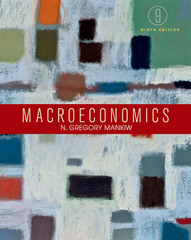Consider an economy with the following CobbDouglas production function: a. Derive the equation describing labor demand in
Question:
Consider an economy with the following Cobb–Douglas production function:![]()
a. Derive the equation describing labor demand in this economy as a function of the real wage and the capital stock.
b. The economy has 27,000 units of capital and a labor force of 1,000 workers. Assuming that factor prices adjust to equilibrate supply and demand, calculate the real wage, total output, and the total amount earned by workers.
c. Now suppose that Congress, concerned about the welfare of the working class, passes a law setting a minimum wage that is 10 percent above the equilibrium wage you derived in part (b). Assuming that Congress cannot dictate how many workers are hired at the mandated wage, what are the effects of this law? Specifically, calculate what happens to the real wage, employment, output, and the total amount earned by workers.
d. Does Congress succeed in its goal of helping the working class? Explain.
e. Do you think that this analysis provides a good way of thinking about a minimumwage law? Why or why not?
Step by Step Answer:






